FINDING REAL ZEROS OF A POLYNOMIAL
Definitions:
• Polynomial: is a function of the form

The numbers
 are called coefficients. an is the leading coefficient, a0 is the
are called coefficients. an is the leading coefficient, a0 is the
constant term and the highest exponent n is the degree of the polynomial.
• Zero: If P is a polynomial and if c is a number such that P(c) = 0 then c is a zero of P .
• The following are all equivalent :
1. c is a zero of P.
2. x = c is an x-intercept of the graph of P .
3. x - c is a factor of P .
4. x = c is a solution of the equation P (x) = 0.
• Rational Zeros Theorem: If the polynomial

has integer coefficients, then every rational zero of P is of the form p/q where
p is a factor of the constant term a0;
and q is a factor of the leading coefficient a n:
• The Rational Zeros Theorem does NOT list irrational
zeros. These will need to be found using other
means like the quadratic formula .
Steps for finding the real zeros of a polynomial:
1. List all possible rational zeros using the Rational
Zeros Theorem.
2. Use synthetic division to test the polynomial at each of the possible
rational zeros that you found in
step 1. (Remember that c is a zero when the remainder is zero.)
3. Repeat step 2 until you reach a quotient that is a quadratic or factors
easily. Use the quadratic
formula or factoring to find the remaining zeros.
Common Mistakes to Avoid:
• The Rational Zeros Theorem does NOT list the rational
zeros of P. It lists all POSSIBLE rational
zeros.
PROBLEMS
Find all real zeros of the polynomial.
1. P(x) = x3 - 7x2 + 14x - 8
Possible Zeros: 
We start by trying 1 in synthetic division.
Remember that 1 is a zero if the remainder
is zero.

Therefore, x = 1 is a our first zero. Since the
quotient resulting from synthetic division is
always one degree less, the quotient that we
have is the quadratic x2 - 6x + 8 which can
easily be factored.
x2 - 6x + 8 = 0
(x - 2)(x - 4) = 0
Setting each factor equal to zero, we get

Real zeros : 1; 2; 4
2. P(x) = 2x3 + 15x2 + 22x - 15
Possible Zeros:

We start by trying -3 in synthetic division.
Remember that -3 is a zero if the remainder
is zero.

Therefore, x = -3 is a our first zero. Since
the quotient resulting from synthetic divi-
sion is always one degree less, the quotient
that we have is the quadratic 2x2 + 9x - 5
which can easily be factored.
2x2 + 9x - 5 = 0
(2x - 1)(x + 5) = 0Setting each factor equal to zero, we get
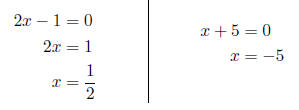
Real zeros : 
3. P(x) = x3 - 22x - 15
Possible Zeros:

We start by trying 5 in synthetic division.
Remember that 5 is a zero if the remainder
is zero.

Therefore, x = 5 is a our first zero. Since the
quotient resulting from synthetic division is
always one degree less, the quotient that we
have is the quadratic x2 +5x+3 which can-
not be factored. Using the quadratic formula
to solve x2 + 5x + 3 = 0, we get
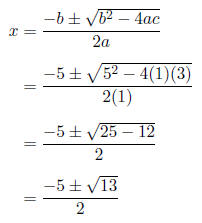
Real zeros : 
4. P(x) = x3 + 3x2 + 6x + 4.
Possible Zeros: 
We start by trying -1 in synthetic division.
Remember that -1 is a zero if the remainder
is zero.

Therefore, x = -1 is a our first zero. Since
the quotient resulting from synthetic divi-
sion is always one degree less, the quotient
that we have is the quadratic
x2 +2x+4 which cannot be factored. Using
the quadratic formula to solve x2+2x+4 = 0,
we get
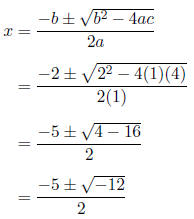
Because there is a negative under the square
root , these zeros are not real. Therefore, we
have no further real zeros.
Real zeros : - 1
5. P(x) = 2x4 + x3 - 16x2 + 3x + 18.
Possible Zeros: 
We start by trying 2 in synthetic division.
Remember that 2 is a zero if the remainder
is zero.

Therefore, x = 2 is a our first zero. However,
our quotient is not a quadratic. Therefore,
we will try to find one more zero by using
synthetic division. We will try -1.

Hence, x = -1 is our second zero. Since the
quotient resulting from this synthetic divi-
sion is the quadratic 2x2 + 3x - 9, we will
factor this to solve.
2x2 + 3x - 9 = 0
(2x - 3)(x + 3) = 0
Setting each factor equal to zero, we get
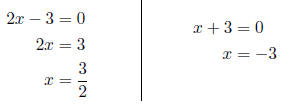
Real zeros : 
6. P(x) = 2x4 + 7x3 - x2 - 15x - 9
Possible Zeros:

We start by trying -1 in synthetic division.
Remember that -1 is a zero if the remainder
is zero.

Therefore, x = -1 is our first zero. However,
our quotient is not a quadratic. Therefore,
we will try to find one more zero by using
synthetic division. We will try -3.

Hence, x = -3 is our second zero. Since
the quotient resulting from this synthetic di-
vision is the quadratic 2x2 - x - 3, we will
factor this to solve.
2x2 - x - 3 = 0
(2x - 3)(x + 1) = 0
Setting each factor equal to zero, we get

Real zeros :

NOTE: x = -1 is a double zero. It occurs
two times . However, you only need to list it
once.
7. P(x) = 6x4 - 8x3 - 41x2 + 23x + 30.
Possible Zeros:
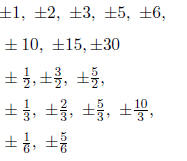
We start by trying 3 in synthetic division.
Remember that 3 is a zero if the remainder
is zero.

Therefore, x = 3 is a our first zero. However,
our quotient is not a quadratic. Therefore,
we will try to find one more zero by using
synthetic division. We will try 

Hence, x = -2/3 is our second zero. Since the
quotient resulting from this synthetic divi-
sion is the quadratic 6x2 + 6x - 15, we need
to solve this.
6x2 + 6x - 15 = 0
3(2x2 + 2x - 5) = 0
Using the quadratic formula to solve
2x2 + 2x - 5 = 0, we get
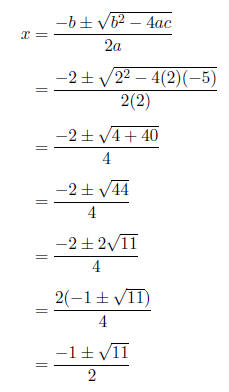
Real zeros : 
| Prev | Next |